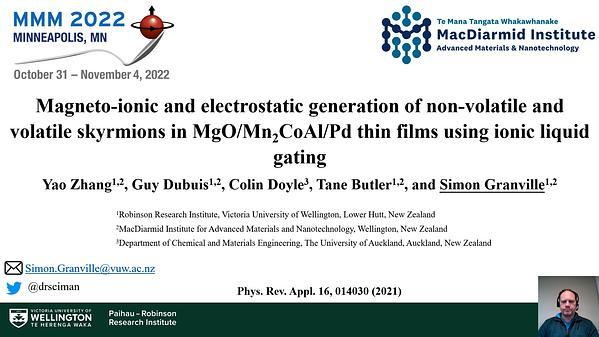Would you like to see your presentation here, made available to a global audience of researchers?
Add your own presentation or have us affordably record your next conference.
Magneto-ionics is an emerging approach to controlling the magnetic properties of materials via voltage-driven ion motion. Nitrogen-based magneto-ionics in transition metal nitride thin films (CoN & FeN) can induce reversible ON-OFF transitions of ferromagnetic states at faster rates and lower threshold voltages than oxygen-based magneto-ionics (1,2), attributed to the comparably smaller energy barrier for ion diffusion and the lower electronegativity of nitrogen when compared with transition metal oxide thin films. Furthermore, this effect largely relies on the strength and penetration of the induced electric field into the target material, the amount of generated ion transport pathways, and the ionic mobility inside the magnetic media. Optimizing all these factors in a simple way is a huge challenge, although highly desirable for technological applications. Here we demonstrate that introduction of suitable transition metal elements in binary nitride compounds can drastically boost magneto-ionics. More specifically, we show the multiple benefits that moderate substitution of Co by Mn brings to the magneto-ionic performance of CoN-based heterostructures. With 10% substitution of Co by Mn in the thin film composition, a transformation from nanocrystalline to amorphous-like structures, as well as from metallic to semiconducting behaviors has been observed. The former increases N ion transport channels, and the latter significantly extends the electric field effect which is normally limited to a few Å in metals. In this way, Mn incorporation leads to a 6.7-fold enhancement of the saturation magnetization (MS) and improved toggling speeds and cyclability. In addition, Ab initio calculations reveal a lower formation energy barrier for Mn-N compared to Co-N, which allows a fundamental understanding of the crucial role of Mn addition on the voltage-driven magnetic effects. These results constitute an important step forward towards enhanced voltage control of magnetism via electric-field-driven ion motion (3).
References:
(1) de Rojas, J. et al. Voltage-driven motion of nitrogen ions: a new paradigm for magneto-ionics. Nature Communications 11, 5871 (2020).
(2) de Rojas, J. et al. Magneto-Ionics in Single-Layer Transition Metal Nitrides. ACS Applied Materials & Interfaces 13, 30826–30834 (2021).
(3) Zhengwei Tan et al. From binary to ternary transition metal nitrides: a boost towards nitrogen magneto-ionics. Submitted (2021).

